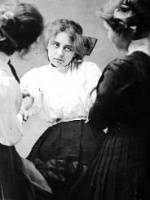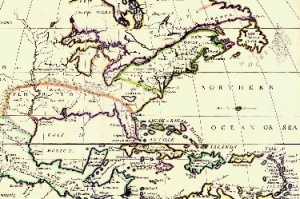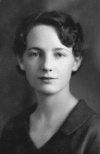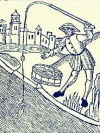Personal tools
Help
Tools
Class Notes
- Do you have news for fellow WSU alumni and other readers of Washington State Magazine? Send us your class note.
Our Story
written by alumni, faculty and friends.
NOTE: THIS IS A LEGACY SITE AND IS NOT REGULARLY MAINTAINED
Views
One Hot Link
From Our Story
www.wsulibs.wsu.edu/holland/masc/masc.htm
By George Bederian
From Washington State University, Fall 2002
For sheer quirkiness and creativity, for example, nothing beats the Frank S. Matsura Image Collection. A Japanese immigrant who lived in Okanogan, Washington, until his death at age 32 in 1913, Matsura broke all the rules of portrait photography in pursuit of his personal vision. In the process, he revealed the souls of his subjects, whose images speak to us after nearly a century with a sometimes unsettling immediacy. I can only wonder what he would have accomplished had he lived longer.
Every one of MASC's digital collections of photographs is a world in itself. Among my favorites are the pages devoted to Frank Fuller Avery, who was connected to the Colville Indian Agency from 1898 to 1916; William Delbert Barkhuff, one of the first students to enroll at WSU; and George Ritchey, an early Pullman resident. Each of these collections opens a window to the past.
Next, check out "Early Modern Printing 1480-1707", where you can view portions of MASC's largely unknown collection of early printed books, superb examples of typography and illustration. Then click to "Celebrating Book Arts in the West", the 1999 exhibit of artist books, fine press editions, and design bindings, to glimpse the astonishing exuberance and creativity of contemporary book arts. Be sure to link to the J. Willard Marriott Library, University of Utah, where you can view the complete exhibit.
You don't have to be a bibliophile to enjoy these exhibits or any of the other pages devoted to books, such as the Leonard and Virginia Woolf collection and the Walker Family Library, "possibly the first private library in the Pacific Northwest."
Another exhibit, "First Women in Graduate Education at Washington State University" honors the pioneering women students who, "through their determination and resolve to fulfill their own educational goals, laid the foundation and set the ground rules for the women who continue to follow in their footsteps."
The MASC site also includes catalog descriptions, fascinating in their own right, but tempting lures for your next non-virtual visit to campus. The Wildlife and Outdoor Recreation Collection brings together two major private collections of books on angling and fishing lore-including a 1772 edition of Isaac Walton's Compleat Angler-with the personal papers of M.S. McGoldrick, Jack (John Woolf) O'Connor, Patrick "Pat" McManus, and Lee Richardson. You can link to Richardson's biography, which is worth a read in itself.
So is the intro to the papers of Lucullus Virgil McWhorter, an interesting character if there ever was one. A self-described "wild, rough and ready field delver" and adopted member of the Yakama Nation, McWhorter was a rancher, amateur historian, and advocate for the Nez Perce and Yakama people.Another link takes you to "Online Books," where you'll find an html version of The Regla Papers, a guide to the papers of "a single extended Mexican elite family" spanning more than 125 years from the middle of the 18th century, and Five Centuries of Veterinary Medicine, the catalog of the Smithcors Veterinary History Collection.
You can also browse through picture books on Pullman (1911) and Coeur d'Alene (1891) and several early WSU publications. And be sure to consult Campus Courtesy (1929-30).
There's a lot more for you to discover in this Website. Once you dive in, I guarantee it won't take you long to associate "archives" with "entertaining," "stimulating," and "fun."
Our Story site map
Our Story main page | Our Story categories | Help Desk
Contact | Give | Advertise
Washington State Magazine | Washington State University | Class Notes
Our Story is coordinated by
In partnership with
Our Story and Washington State Magazine are publications of Washington State University. All rights reserved.
P.O. Box 641227, Washington State University, Pullman, WA 99164-1227 USA | wsm@wsu.edu, 509-335-2388
Accessibility | Copyright | Policies




